Let's check up on Dokdo.Are you interested in Dokdo-related stories? Please click now.
The Bronze Age or the early Iron Age
The Bronze Age (1000 - 300 BC) or the early Iron Age (300 - 1 AD) People began living on Ulleungdo Island.
Relics discovered in Ulleungdo Island: dolmen, plain earthenware, milling stone, grindstone (in Hyeonpo-ri, Namseo-ri, and Jeodong-ri)
Relics discovered in Ulleungdo Island: dolmen, plain earthenware, milling stone, grindstone (in Hyeonpo-ri, Namseo-ri, and Jeodong-ri)
512
 Samguk sagi (History of the Three Kingdoms)
Samguk sagi (History of the Three Kingdoms)
 Samguk sagi (History of the Three Kingdoms)
Samguk sagi (History of the Three Kingdoms)
Silla's subjugation of Usanguk Yisabu, an official of Silla, subjugated Usanguk, thus making Ulleungdo and Dokdo Islands a part of the country's history. Dongguk Munheon Bigo (Reference Compilation of Documents on Korea, 1770) says that Ulleung (Ulleungdo Island) and Usan (Dokdo) were both parts of Usanguk's territory.
1454
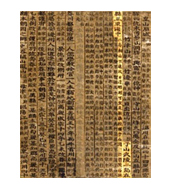 Sejong Sillok Jiriji (Geography Section of the Annals of King Sejong)
Sejong Sillok Jiriji (Geography Section of the Annals of King Sejong)
 Sejong Sillok Jiriji (Geography Section of the Annals of King Sejong)
Sejong Sillok Jiriji (Geography Section of the Annals of King Sejong)
Sejong Sillok Jiriji This book, compiled by the Joseon government in its early days, states that Ulleungdo and Dokdo Islands belonged to Uljin-hyeon, Gangwon-do. It is noteworthy that Usan (Dokdo) and Mureung (Ulleungdo Island) are not far away from each other, and thus were visible from each other on a clear day. Dokdo is the only distant island that can be seen from Ulleungdo by the naked eye on a clear day.
1625
 A view of Ulleungdo Island
Courtesy of the Ulleung-Gun County Office
A view of Ulleungdo Island
Courtesy of the Ulleung-Gun County Office
 A view of Ulleungdo Island
A view of Ulleungdo Island
Permit to sail to Takeshima (Ulleungdo Island) The Bakufu (Shogunate) of Japan issued a permit allowing two families (named Oya and Murakawa) in Tottori Domain (present-day Tottori Prefecture) to sail to Takeshima (Ulleungdo Island) in either 1618 or 1625.
1693
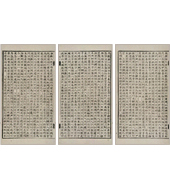 Sukjong Sillok (The Veritable Record of the Reign of King Sukjong)
Sukjong Sillok (The Veritable Record of the Reign of King Sukjong)
 Sukjong Sillok (The Veritable Record of the Reign of King Sukjong)
Sukjong Sillok (The Veritable Record of the Reign of King Sukjong)
An Yongbok is forcefully taken to Japan. Two Koreans, An Yongbok and Park Eodun, were fishing near Ulleungdo Island when they were taken by force to Japan by members of the Oya and Murakawa families of Japan. The incident led to a dispute between Korea and Japan over the territorial sovereignty of Ulleungdo Island.
1694
 A View of Ulleungdo Island
Courtesy of the Ulleung-Gun County Office
A View of Ulleungdo Island
Courtesy of the Ulleung-Gun County Office
 A View of Ulleungdo Island
A View of Ulleungdo Island
Decision on periodic inspection of the current status of Ulleungdo Island In response to the An Yongbok-initiated territorial dispute over Ulleungdo Island with Japan, the Joseon government sent Jang Hansang, a local official of Samcheok to examine the overall status of Ulleungdo Island. Then, it was decided to dispatch an official to the island twice a year for that purpose, as suggested by the Prime Minister Nam Guman.
1695
 Tottori Domain's reply (A reproduced copy)
Tottori Domain's reply (A reproduced copy)
 Tottori Domain's reply (A reproduced copy)
Tottori Domain's reply (A reproduced copy)
Japan Tottori Domain's reply The Japan Bakufu asked the Tottori Domain, to which Ulleungdo Island belonged, to determine whether the island was a part of Japan's territory or Korea's on December 24, 1695. The following day, the Tottori Domain replied that neither Takeshima (Ulleungdo Island) nor Matsushima (Dokdo) belonged to it. In other words, the Bakufu issued an official denial to the effect that neither Ulleungdo Island nor Dokdo was a part of the Japanese territory.
1696
 Prohibition of voyages to Takeshima (Ulleungdo Island) (A reproduced copy)
Courtesy of the Dokdo Museum
Prohibition of voyages to Takeshima (Ulleungdo Island) (A reproduced copy)
Courtesy of the Dokdo Museum
 Prohibition of voyages to Takeshima (Ulleungdo Island) (A reproduced copy)
Prohibition of voyages to Takeshima (Ulleungdo Island) (A reproduced copy)
In January; Prohibition of voyages to Takeshima (Ulleungdo Island) After it was confirmed by the Tottori Domain that Ulleungdo and Dokdo Islands were not part of Japan's territory, the Japan Bakufu issued an order prohibiting Japanese people from sailing there on January 28, 1696. Later, it sent Joseon a diplomatic document officially confirming that Ulleungdo Island belonged to Joseon (1699).
1696
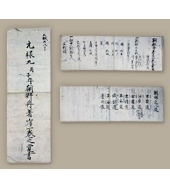 One-volume memorandum concerning the Korean boat that came onto Oki Island in the ninth year of Genroku
One-volume memorandum concerning the Korean boat that came onto Oki Island in the ninth year of Genroku
 One-volume memorandum concerning the Korean boat that came onto Oki Island in the ninth year of Genroku
One-volume memorandum concerning the Korean boat that came onto Oki Island in the ninth year of Genroku
In May; An Yongbok's voyage to JapanAn Yongbok drove away Japanese fishing near Ulleungdo Island and sailed to the Oki Island, Tottori Domain to protest about the presence of Japanese fishermen near Ulleungdo Island. This memorandum records the facts.
1770
 Dongguk Munheon Bigo (Reference Compilation of Documents on Korea)
Dongguk Munheon Bigo (Reference Compilation of Documents on Korea)
 Dongguk Munheon Bigo (Reference Compilation of Documents on Korea)
Dongguk Munheon Bigo (Reference Compilation of Documents on Korea)
Yeojigo of Dongguk Munheon Bigo This book recording the culture and civilization of Joseon was officially compiled at the order of King Yeongjo. The books say, "Ulleung and Usan both belong to Usanguk. Usan is what the Japanese call Matsushima."
1870
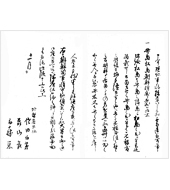 Chosenkok Kosaishimatsu Naitansho (Report on the Confidential Inquiry into the Particulars of Korean Foreign Relations) (A reproduced copy)
Courtesy of Dokdo Museum
Chosenkok Kosaishimatsu Naitansho (Report on the Confidential Inquiry into the Particulars of Korean Foreign Relations) (A reproduced copy)
Courtesy of Dokdo Museum
 Chosenkok Kosaishimatsu Naitansho (Report on the Confidential Inquiry into the Particulars of Korean Foreign Relations) (A reproduced copy)
Chosenkok Kosaishimatsu Naitansho (Report on the Confidential Inquiry into the Particulars of Korean Foreign Relations) (A reproduced copy)
Chosenkok Kosaishimatsu Naitansho This is a report submitted by Hakubo SATA and his colleague, who were officials of the Foreign Ministry of Japan, to their ministry after conducting an inspection tour of Joseon. The report refers to "the situation in which Takeshima (Ulleungdo Island) and Matsushima (Dokdo) became attached to Joseon." It reveals that the Foreign Ministry of Japan viewed the two islands as Joseon territory at that time.
1877
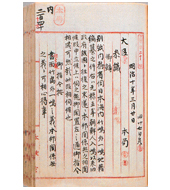 Dajokan's Order
Dajokan's Order
 Dajokan's Order
Dajokan's Order
Dajokan's Order In March 1877, the Dajokan (Grand Council of State) of Japan handed an order to the Interior Ministry to the effect that Ulleungdo and Dokdo were not Japanese territory. Dajokan judged that the two islands did not belong to Japan as a result of talks held between the Edo Bakufu of Japan and the Joseon government in the seventeenth century, and instructed the Interior Ministry as follows: "You should bear in mind that 'Takeshima (Ulleungdo Island) and one other island (i.e. Dokdo) have nothing to do with our country (Japan)."
1900
 Imperial Order No. 41
Imperial Order No. 41
 Imperial Order No. 41
Imperial Order No. 41
Promulgation of Imperial Order No. 41 Emperor Gojong of the Korean Empire personally issued this order to rename Ulleungdo and the island's administrator as 'Uldo' and 'Headman', respectively. Article 2 of the Imperial Order stipulates that the areas to be controlled by the Uldo-Gun Office should include all of Ulleungdo, Jukdo, and Seokdo (Dokdo) Islands.
1905
 Courtesy of the Dokdo Museum
Courtesy of the Dokdo Museum

Shinema Prefecture Public Notice No. 40 This is a municipal notice concerning Japan's illegal incorporation of Dokdo into its territory. During the Russo-Japanese War (1904-1905), which was fought over the protagonists' respective interests in Manchuria and the Korean Peninsula, the Japanese government recognized the importance of Dokdo during its battles in the East Sea and forcefully incorporated it in 1905, asserting that it was terra nultius (a land belonging to no one), as stated in this public notice issued by Shimane Prefecture. However, this was merely a part of a long process of phased pillaging of Joseon's sovereignty. It was an illegal act that infringed Joseon's sovereignty over Dokdo, which had been firmly established many years previously. Thus, the announcement of its incorporation of Dokdo could not be recognized under international law.
1906
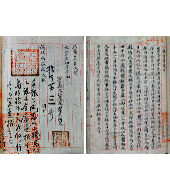 Report and Order No. 3
Report and Order No. 3
 Report and Order No. 3
Report and Order No. 3
In March, A report submitted by Uldo County Headman SIM Heungtaek A delegation of officials and civilians from Shimane Prefecture of Japan paid a visit to Sim Heungtaek, the headman of Uldo County, to inform him that Japan had incorporated Dokdo into its territory. The following day, Sim submitted this report, in which he clearly states "Dokdo, which belongs to my county", to the Gangwon-do Governor and the Interior Ministry.
In May
Euijeongbu (State Council of Joseon), Vice Prime Minister Order No. 3 This order to refuse to accept Japan's incorporation of Dokdo Islands into its territory was issued by the Deputy Prime Minister of the Euijeongbu (State Council of the Korean Empire) upon receiving the report from the Gangwon-do Governor.
In May
Euijeongbu (State Council of Joseon), Vice Prime Minister Order No. 3 This order to refuse to accept Japan's incorporation of Dokdo Islands into its territory was issued by the Deputy Prime Minister of the Euijeongbu (State Council of the Korean Empire) upon receiving the report from the Gangwon-do Governor.
1946
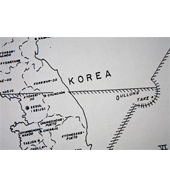 SCAPIN No. 677-related map (A reproduced copy)
Courtesy of the Dokdo Museum
SCAPIN No. 677-related map (A reproduced copy)
Courtesy of the Dokdo Museum
 SCAPIN No. 677-related map (A reproduced copy)
SCAPIN No. 677-related map (A reproduced copy)
January 29. Supreme Commander for the Allied Powers Order (SCAPIN) No. 677 This order, issued after the end of the Pacific War, is about exclusion of Dokdo from Japan's territory. It states: " The territory of Japan does not include Ulleungdo Island, Liancourt Rocks (Dokdo) and Jeju Island."
June 22
SCAPIN No. 1033. It prohibits Japanese boats or people from entering a 12 nautical mile limit around Dokdo.
June 22
SCAPIN No. 1033. It prohibits Japanese boats or people from entering a 12 nautical mile limit around Dokdo.
1951
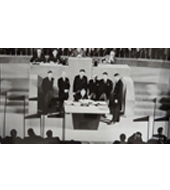 Signing of the Treaty of San Francisco
Courtesy of the National Archives and Records Administration
Signing of the Treaty of San Francisco
Courtesy of the National Archives and Records Administration
 Signing of the Treaty of San Francisco
Signing of the Treaty of San Francisco
Signing of the Treaty of San Francisco This is the treaty signed by the Allied Powers with Japan at the end of the Pacific War. Article 2 (a) of the Treaty states: "Japan, recognizing the independence of Korea, renounces all rights, titles and claims to Korea, including the islands of Quelpart, Port Hamilton and Dagelet." The islands referred to here are but a few examples of the more than 3,000 islets situated in Korean waters. Therefore, it does not make any sense at all to assert that Dokdo is not included in Korea's territory simply because it is not explicitly mentioned in the Treaty.

